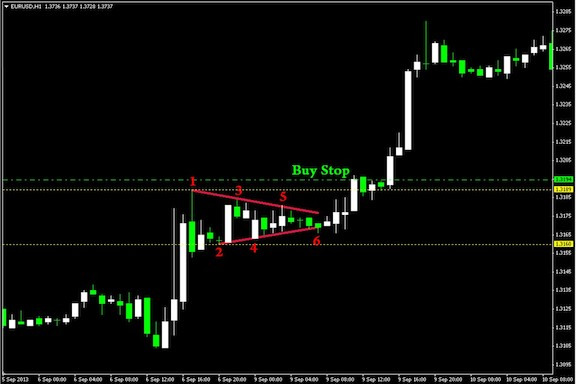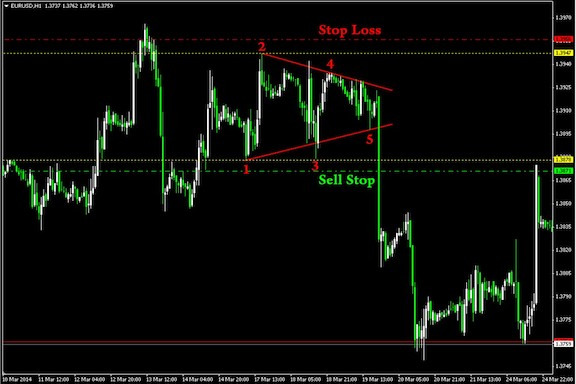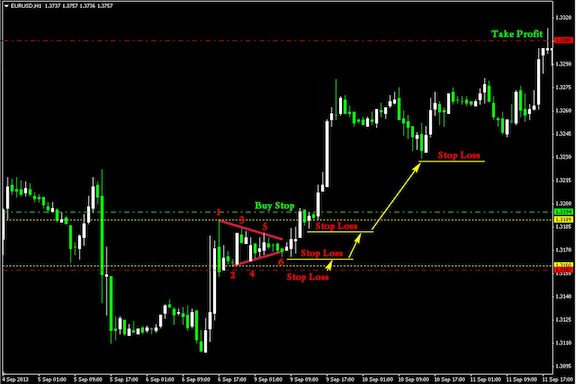Trading by Price Action can be tricky sometimes. Personally, I used to trade daily pin bars for a year but always felt quite unsafe in the market because a price pattern consisting of just one candlestick looks untrustworthy, and my doubts got confirmed by practice rather often.
Meanwhile, the Triangle strategy uses patterns consisting of a group of candlesticks, multidirectional movements, and extremes. All those need time to form, which is good because time is also needed for consolidation that normally precedes further growth of falling of the price.
The Triangle trading strategy can be used on timeframes from M1 to MN in Forex, futures, or stock markets. By the way, Triangle presumes the use of a horizontal and converging triangle only because this is the simplest type of the pattern that is situated in a limited range, unlike diverging or inclined triangle types.
Signal to buy by Triangle
Best signals appear right after a strong price movement instead of a correction. However, triangles can appear anywhere, so be careful. So, here are the requirements to the horizontal converging triangle that can be used as a signal to buy by the strategy:
· The triangle must consist of five or more alternate local highs and lows.
· Each next local high in the triangle must not be higher than the previous one.
· Each next local low in the triangle must not be lower than the previous one.
After the signal pattern is complete, calculate the tick distance from the first to the second extreme. Then mark 10% of the tick distance upwards from the highest extreme plus the spread – and place a pending Buy Stop order there. Here is an example of a signal to buy by Triangle in the stock, futures, or Forex markets:

If the tick number is not round, round it up.
Signal to sell by Triangle
The requirements to the signal pattern for selling are practically the same as to that for buying. Only for finding the Sell Stop level we mark the 10% of the distance between the farthest extremes down from the lowest local low but without the spread. An example of a signal to sell by Triangle:

This trading pattern is not that perfect as in the previous example. If you look closer, you will see supposed violations of the requirements. Yet if you read the conditions more attentively, you will realize that you may still sell by the pattern. Sure, in the place of the third extreme there are two local lows the second of which is higher than the first one. Still, if you take the lowest one for the third extreme of the pattern, as the strategy requires, it turns out no lower than the first one, which is vital. I give you an imperfect example on purpose because perfect triangles are in minority.
Does the strategy let us place two pending orders – to buy and to sell – in a triangle at once? Theoretically, it does, especially when the triangle forms after a correction of some sort, not just after a momentum.
However, in a triangle right after a momentum you still can place two orders at once because, as the Elliott theory goes, such a triangle may appear in the one but last wave of the higher level. And as long as the fifth wave can be truncated, you can trade by the strategy in the opposite direction from the last momentum. Anyway, be careful trading against the trend and try to avoid this altogether.
Stop Loss and Take Profit in Triangle
The calculation principle for protective orders is the same as for the Buy Stop and Sell Stop orders: in case of buying, mark 10% of the tick size of the complete signal pattern down from the lowest extreme. Can you trail such a position by the strategy? You not only can do it, you should: you can transfer the order for the first time when – in case of buying – a candlestick closes higher than the whole triangle and a second one opens and closes above it. As a rule, when such a breakaway happens, the price is very unlikely to reverse.
By the way, make sure you delete your second order right after the first one is triggered because the levels of such orders coincide with SL levels, so you can miss the inactive order and forget about it completely.
Transfer the position to the breakeven as soon as the price covers the same number of ticks in the direction of profit that you are risking. Trail the position by Triangle by the same principle that the first transfer of the SL was made by: if you position is long, place it behind the last local low right after a candlestick closes above the last local high plus one more candlestick opens and closes.
As for the Take Profit level, the strategy requires that you set it based on your own reliable methods. This can be the Fibonacci percentage method or a simple 2-to-2 or 3-to-1 relation. I am afraid, every trading situation has its own potential, so I cannot recommend a universal method.
Money management with Triangle
This strategy suits trading a set lot, necessarily recalculated after each closed order, and risking a set percentage of your current deposit (I mean “balance” that does not account for floating profits and losses from open positions). The expediency of using this or that method depends also on the TF you are trading on.
If you prefer percent risks that are quite comfortable in this strategy because of pending orders, I recommend no more than 1-2% of your current deposit. Even if you normally trade larger risks, give some time for yourself to get accustomed to the strategy.
Example of using the Triangle strategy

In this example, I used a three times larger TP that the SL. I illustrated the trailing by arrows, yet you should transfer the position to the breakeven right after the price covers in the direction of the profit the distance of your initial risk.
I admit I designed this strategy quite long ago on M1 of GBP/USD, and it used to work well. Unfortunately, my greed got on me, and I made a mistake that led to losing a major part of my deposit: I started entering all triangles indiscriminately, regardless of in how many positions I was risking already. As a result, I found myself in a sideways movement full of triangles with false triggering of orders. Do not repeat my mistake, risk in just one position at once. Open the second position only after the previous one is closed or transferred to the breakeven. Good luck!
By Dmitriy Gurkovskiy, Chief Analyst at RoboForex




